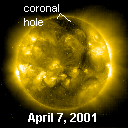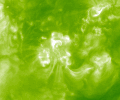|   SPACE WEATHER SPACE WEATHER
Current
Conditions
Solar Wind
velocity: 525.8 km/s
density:7.2 protons/cm3
explanation | more data
Updated: Today at 2244 UT
X-ray Solar Flares
6-hr max: C1 2250 UT Apr07
24-hr: C2 2240 UT Apr06
explanation | more data
Updated: Today at 2250 UT
Daily Sun: 07 Apr '01 
AR9415 unleashed an X1-class flare on April 3rd and an X5-class flare on April 6th. Covering an area five times greater than the surface area of Earth, 9415 is clearly the most potent source of activity on the Sun's disk and one that bears watching during the days ahead.
Sunspot Number: 136
More about sunspots
Updated: 06 Apr 2001
Radio Meteor Rate
24 hr max: 156 per hr
Listen to the Meteor Radar!
Updated: 07 Apr 2001 Interplanetary Mag. Field
Btotal: 7.7 nT
Bz: 4.6 nT north
explanation | more data
Updated: Today at 2247 UT Coronal Holes:

The only substantial coronal hole is near the Sun's north pole. It is not well-positioned to send a solar wind stream toward Earth. Image credit: SOHO Extreme UV Telescope.
More about coronal holes
 SPACE WEATHER SPACE WEATHER
NOAA
Forecasts
Solar Flares: Probabilities for a medium-sized (M-class) or a major (X-class) solar flare during the next 24/48 hours are tabulated below.
Updated at 2001 Apr 07 2200 UT
| FLARE | 24 hr | 48 hr | | CLASS M | 80 % | 80 % | | CLASS X | 25 % | 25 % |
Geomagnetic Storms: Probabilities for significant disturbances in Earth's magnetic field are given for three activity levels: active, minor storm, severe storm
Updated at 2001 Apr 07 2200 UT Mid-latitudes | 24 hr | 48 hr | | ACTIVE | 40 % | 40 % | | MINOR | 30 % | 30 % | | SEVERE | 10 % | 10 % |
High latitudes | 24 hr | 48 hr | | ACTIVE | 40 % | 40 % | | MINOR | 35 % | 35 % | | SEVERE | 15 % | 15 % |

Web server provided by
VPS Hosting
| What's Up in Space -- 7 Apr 2001
Subscribe to Space Weather News! IMPACT: An interplanetary shock wave passed NASA's ACE spacecraft at 1700 UT on April 7th and hit Earth's magnetosphere about 30 minutes later. The shock was generated by a coronal mass ejection that left the Sun on Thursday when an M5-category solar flare exploded near sunspot group 9415.  Soon after today's impact the interplanetary magnetic field near Earth turned north -- a condition that is unfavorable for auroras. Nevertheless, sky watchers living above ~55 degrees geomagnetic latitude should remain alert for Northern Lights after local nightfall. A second CME, spawned by Friday's powerful X5-class flare, could arrive later today or Sunday.  X-FLARE: On Friday, a powerful X5-class solar flare exploded near sunspot group 9415. The blast propelled a lopsided coronal mass ejection (CME) into space -- and somewhat toward Earth. Active region 9415 has a complex magnetic field that probably harbors energy for additional X-flares -- explosions that would squarely target our planet as the spot crosses the Sun's central meridian in the days ahead. Above: A SOHO extreme ultraviolet animation of the solar flare. X-FLARE: On Friday, a powerful X5-class solar flare exploded near sunspot group 9415. The blast propelled a lopsided coronal mass ejection (CME) into space -- and somewhat toward Earth. Active region 9415 has a complex magnetic field that probably harbors energy for additional X-flares -- explosions that would squarely target our planet as the spot crosses the Sun's central meridian in the days ahead. Above: A SOHO extreme ultraviolet animation of the solar flare.
SUPERFLARE: The most powerful solar flare in at least 25 years erupted near the giant sunspot 9393 on April 2nd. Fortunately, the bulk of the "X20-class" blast was directed away from Earth. It did little more than trigger a modest radiation storm around our planet and -- two days after the eruption -- a minor geomagnetic storm. See also: WEB LINKS: NOAA FORECAST | GLOSSARY | SPACE WEATHER TUTORIAL | LESSON PLANS | BECOME A SUBSCRIBER |  
Potentially Hazardous Asteroids (PHAs) are space rocks larger than approximately 100m that can come closer to Earth than 0.05 AU. None of the known PHAs are on a collision course with our planet, although astronomers are finding new ones all the time. [more]
On 7 Apr 2001 there were 299 known Potentially
Hazardous Asteroids ASTEROIDS GALORE: March was a good month for asteroid hunters. Between March 21st and 31st astronomers discovered seven Earth-approaching space rocks (click to view 3D orbits): 2001 FM129, 2001 FE90, 2001 FB90, 2001 FD58, 2001 FC58, 2001 FA58 and 2001 FO32. There is no danger of a collision with any of these asteroids. Earth-asteroid encounters (Mar 1 - Apr 30) 
- TOTAL LUNAR ECLIPSE: On Jan. 9, 2001, the full Moon glided through Earth's copper-colored shadow. [gallery]
- CHRISTMAS ECLIPSE: Sky watchers across North America enjoyed a partial solar eclipse on Christmas Day 2000 [gallery]
- LEONIDS 2000: Observers around the globe enjoyed three predicted episodes of shooting stars. [gallery]
 Feb. 21, 2001: Nature's Tiniest Space Junk -- Using an experimental radar at the Marshall Space Flight Center, scientists are monitoring tiny but hazardous meteoroids that swarm around our planet. Feb. 15, 2001: The Sun Does a Flip -- NASA scientists who monitor the Sun say our star's enormous magnetic field is reversing -- a sure sign that solar maximum is here. Jan. 25, 2001: Earth's Invisible Magnetic Tail -- NASA's IMAGE spacecraft, the first to enjoy a global view of the magnetosphere, spotted a curious plasma tail pointing from Earth toward the Sun. Jan. 4, 2001: Earth at Perihelion -- On January 4, 2001, our planet made its annual closest approach to the Sun. Dec. 29, 2000: Millennium Meteors -- North Americans will have a front-row seat for a brief but powerful meteor shower on January 3, 2001. Dec. 28, 2000: Galileo Looks for Auroras on Ganymede -- NASA's durable Galileo spacecraft flew above the solar system's largest moon this morning in search of extraterrestrial "Northern Lights" Dec. 22, 2000: Watching the Angry Sun -- Solar physicists are enjoying their best-ever look at a Solar Maximum thanks to NOAA and NASA satellites. MORE SPACE WEATHER HEADLINES |

